Karađorđević dynasty
The Karađorđević (Serbian Cyrillic: Карађорђевић, pl. Karađorđevići / Карађорђевићи, pronounced [karad͡ʑǒːrd͡ʑeʋit͡ɕ]) is a Serb dynasty, founded by Karađorđe Petrović, the veliki vožd ("grand leader") of Serbia in the early 1800s during the First Serbian Uprising. The relatively short-lived dynasty was supported by the Russian Empire and was opposed to the Austria-Hungary-supported Obrenović dynasty. After Karađorđe's assassination in 1817, Miloš Obrenović founded the House of Obrenović. The two houses subsequently vied for the throne for several generations. Following the assassination of Alexander in 1903, the Serbian Parliament chose Karađorđe's grandson, Peter I Karađorđević, then living in exile, for the throne of the Kingdom of Serbia. He was duly crowned as King Peter I, and shortly before the end of World War I, representatives of the three peoples proclaimed a Kingdom of the Serbs, Croats and Slovenes with Peter I as sovereign. In 1929, the kingdom was renamed Yugoslavia, under Alexander I, the son of Peter I. In November 1945, the throne was lost when the League of Communists of Yugoslavia seized power, during the reign of Peter II.
| Karađorđević Карађорђевић | |
|---|---|
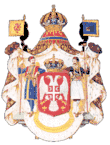 | |
| Country | |
| Founded | 14 February 1804 |
| Founder | Karađorđe Petrović |
| Current head | Alexander II Karađorđević |
| Final ruler | Peter II |
| Titles |
|
| Deposition | 29 November 1945 |
Name
In English, it is typically spelled Karadjordjevic while pronunciation is roughly anglicized as Karageorgevitch, and was in previous times rendered also as Kara-Georgevitch.
Ancestry
According to some researchers, Karađorđe's paternal ancestors most likely migrated from the Highlands (in what is today Montenegro) to Šumadija during the Second Great Serb Migration in 1737–39 under the leadership of Patriarch Šakabenta, as a result of the Austro-Turkish War (in which Serbs took part).[1] Serbian historiography accepted the theory that Karađorđe's ancestors came from Vasojevići.[2]
Some conjecture has arisen about where the family ended up after arriving in Šumadija. According to Radoš Ljušić, Karađorđe's ancestors most likely hailed from Vasojevići, but he has said there is no certain historical information on Karađorđe's ancestors or where they came from, folklore being the only real source. Most likely, Karađorđe's ancestors hailed from Vasojevići.[3][4][5] Grigorije Božović (1880–1945) claimed that the family were Srbljaci (natives) in Vasojevići territory.[6] Contributing to Srbljak theory is the fact that the family celebrated St Clement as their Slava until 1890, while the patron saint of Vasojevići, i.e. Vaso's descendants is Archangel Michael. King Peter I was allowed to change his Slava to St Andrew the First-called by Belgrade Metropolitan Mihailo in 1890, following the death of his wife, Princess Zorka, thus honoring the date by Julian calendar when Serbian rebels liberated Belgrade during the First Serbian Uprising.[7][8]
Furthermore, King Peter chose Duke of Vasojevići Miljan Vukov Vešović to be his bridesman during his wedding to princess Zorka in 1883. Upon being asked by his future father-in-law prince Nicholas why he chose Miljan amongst various Dukes of Montenegro, he replied that he chose him because of heroism and relation describing him as Vojvode of my own blood and kin.[9] His son, Alexander, who was born in Cetinje was nicknamed Montenegrin[10] The Vasojevići tribe claim descent from Stefan Konstantin of the Nemanjić dynasty.[4] The Vasojevići were proud of Karađorđe, and saw him as their kinsman.[11] Montenegrin politician and Vasojević Gavro Vuković, supported this theory.[12] Accordingly, Alexander Karađorđević (1806-1885) was given the title "Voivode of Vasojevići" by Petar II in 1840.[12][13] Other theories include: Montenegrin historian Miomir Dašić claimed that Karađorđe's family originated from the Gurešići from Podgorica in Montenegro.[6] Folklorist Dragutin Vuković believed that Tripko Knežević–Guriš was Karađorđe's great-grandfather;[6] Vukićević, writing in 1907, said that in the surroundings of Podgorica, there is a local claim that Karađorđe's ancestors initially came from Vranj.[14]
The family claimed descent from the Vasojevići tribe (in Montenegro) and had emigrated in the late 1730s or early 1740s.[15] The family lived in Mačitevo (in Suva Reka), from where grandfather Jovan moved to Viševac, while Jovan's brother Radak moved to Mramorac.[3][4] According to Serbian socialist Dimitrije Tucović and publicist Miroslav Ćosovic, the ancestors of Karađorđević are part of the Vasojevići tribe, which according to them is of Albanian origin.[16][17][18]
Monarchs
| Picture | TitleName | Reign | Notes |
|---|---|---|---|
 | Grand Vožd of Serbia Karađorđe Petrović | February 15, 1804 – September 21, 1813 | Leader of the First Serbian Uprising. Deposed and exiled to Austria. Collapse of the First Serbian Uprising. |
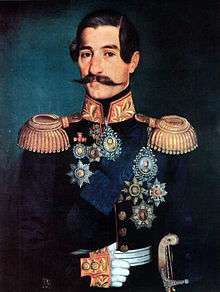 | Prince of Serbia Alexander | September 14, 1842 – December 23, 1858 | Abdicated. Return of Obrenović dynasty to power. |
 | King of Serbia; King of Serbs, Croats and Slovenes Petar I | June 15, 1903 – August 16, 1921 | In exile from November 1915 due to the Serbian Campaign. Proclaimed King of Serbs, Croats and Slovenes on December 1, 1918. |
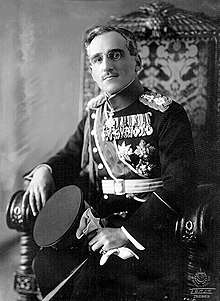 | King of Serbs, Croats and Slovenes; King of Yugoslavia Alexander I | August 16, 1921 – October 9, 1934 | Changed title to "King of Yugoslavia" in 1929. Assassinated in Marseilles. |
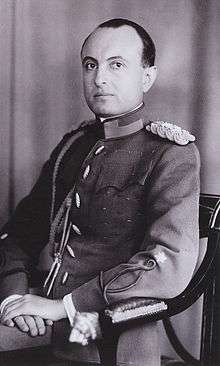 | Prince regent of Yugoslavia Paul | October 9, 1934 – March 27, 1941 | Prince Regent for Peter II. |
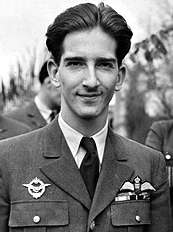 | King of Yugoslavia Peter II | October 9, 1934 – November 29, 1945 | Prince Paul acted as regent until ousted on March 27, 1941; exiled on April 17, 1941, and deposed on November 29, 1945. |
Current claims to the throne
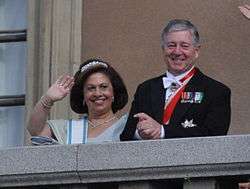
The Karađorđevićs are active in Serbian society in various ways. There is a view that constitutional parliamentary monarchy would be the ultimate solution for stability, unity and continuity. In addition, they support Serbia as a democratic country with a future in the European Union.
The last crown prince of Yugoslavia, Alexander, has lived in Belgrade in the Dedinje Royal Palace since 2001. As the only son of the last king, Peter II, who never abdicated, and the last official heir of the Kingdom of Yugoslavia he claims to be the rightful heir to the Serbian throne in the event of restoration.[19][20] Prior to the fall of Slobodan Milošević, he personally united the parliamentary opposition in several major congresses. In the palace, he regularly receives religious leaders and strives, as opportunity permits, to demonstrate his commitment to human rights and to democracy.
The Karađorđevićs are much engaged in humanitarian work. Crown Princess Katherine has a humanitarian foundation while Crown Prince Alexander heads the Foundation for Culture and Education, whose activities include student scholarships, summer camps for children, etc. The Karađorđevićs are also prominent in national sports activities.
Serbia and Yugoslavia
The Karadjordjević family initially was a Serbian Royal House, then the Royal House of the Serbs, Croats and Slovenes and then the Royal House of Yugoslavia. When they last reigned they were called the Royal House of Yugoslavia.
Crown Prince Alexander was born in London but on property temporarily recognised by the United Kingdom's government as subject to the sovereignty of the Yugoslav crown, on which occasion it was publicly declared that the Crown Prince had been born on the native soil of the land he was expected to eventually rule.[21]
Heraldry
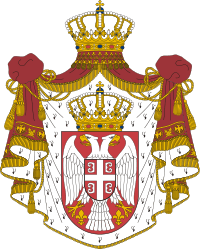 Coat of arms of Serbia
Coat of arms of Serbia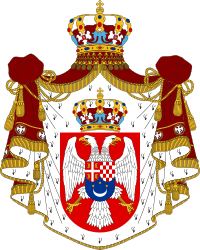 Coat of arms of Yugoslavia
Coat of arms of Yugoslavia
Family tree
| Karađorđe b. 1768 – d. 1817 reigned 1804–1813 | |||||||||||||||||||||||||||||||||||||||||||||||||||||||||||||||||||||||||||||
| Alexis b. 1801 – d. 1830 | Alexander Karađorđević b. 1806 – d. 1885 reigned 1842–1858 | ||||||||||||||||||||||||||||||||||||||||||||||||||||||||||||||||||||||||||||
| George b. 1827 – d. 1884 | Peter I b. 1844 – d. 1921 reigned 1903–1921 | Arsen b. 1859 – d. 1938 | |||||||||||||||||||||||||||||||||||||||||||||||||||||||||||||||||||||||||||
| Alexis b. 1859 – d. 1920 | Bojidar b. 1862 – d. 1908 | George b. 1887 – d. 1972 | Alexander I b. 1888 – d. 1934 reigned 1921–1934 | Paul Karađorđević b. 1893 – d. 1976 ruled 1934–1941 (as Prince Regent) | |||||||||||||||||||||||||||||||||||||||||||||||||||||||||||||||||||||||||
| Peter II b. 1923 – d. 1970 reigned 1934–1945 | Tomislav b. 1928 – d. 2000 | Andrew b. 1929 – d. 1990 | Alexander b. 1924 – d. 2016 | Nicholas b. 1928 – d. 1954 | |||||||||||||||||||||||||||||||||||||||||||||||||||||||||||||||||||||||||
| Alexander Karađorđević b. 1945 | Nicholas b. 1958 George b. 1984 Michael b. 1985 | Karl Vladimir b. 1964 Dimitri Mihailo b. 1965 | Dimitri b. 1958 | Michael b. 1958 | Sergius b. 1963 | Dušan b. 1977 | |||||||||||||||||||||||||||||||||||||||||||||||||||||||||||||||||||||||
| Peter b. 1980 | Philip b. 1982 | Alexander b. 1982 | |||||||||||||||||||||||||||||||||||||||||||||||||||||||||||||||||||||||||||
| Stefan b. 2018 | |||||||||||||||||||||||||||||||||||||||||||||||||||||||||||||||||||||||||||||
References
- "Pastir u najmu".
- "Srpsko Nasledje". Srpsko Nasledje. Retrieved August 15, 2012.
- Bogdan Popović, Jovan Skerlić (1932). Srpski književni glasnik, Volumes 35-36. p. 282.
- R-J. V. Vesović, 1935, "Pleme Vasojevići", Državna Štampa u Sarajevu, Sarajevo
- Felix Phillip Kanitz 1987, p. 334: "Као што је доказао Ђукић10, велики српски борац за слободу угледао је свој први дан живота 1752. у Вишевцу, окруженом густом храстовом шумом, где се његов отац доселио из Васојевића у Црној Гори."
- (redjasna@yahoo.com), Veselin Ostojin (happynose@geocities.com), Jasmina Maric. "Srpsko Nasledje". www.srpsko-nasledje.co.rs.
- "MISTERIJA SLAVE KARAĐORĐEVIĆA: Evo kojim svecima su se molili preci Karađorđa!".
- "Čuvaju slavu velikog vožda".
- btgport.net. "Karađorđevići porijeklom iz Vasojevića". mojenovosti.com.
- "Надимци старих Београђана - Politikin Zabavnik". politikin-zabavnik.co.rs.
- Pregled, Volume 9 (in Serbian). Nova tiskara Vrček i dr. 1933.
Васојевићи нарочито радо причају о војводама Србије који су имали везе са њиховим племеном или из њега старином потичу. Говоре често о Карађорђу, зову га Карађоко и сматрају га као свој изданак.
- Vuković 1985
- "Његово мишљење је почетком прошлог века прихватио и историчар Вукићевић, прилажући као доказ диплому коју је 1840. године владика црногорски Петар II Петровић Његош издао Вождовом сину Александру Карађорђевићу, у којој се каже да Вожд потиче од "древних кнезова наше провинције Васојевића"".
- Vukićević 1907, p. 5: "околини Подгорице и у селу Врању. А да је Карађорђе старинбм из села Врања, чуо је у Црној Гори још 1875 године г.
- Király & Rothenberg 1982, p. 23.
- "Serbien und Albanien: ein kritischer Beitrag zur Unterdrückungspolitik der serbischen Bourgeoisie". Albanian History (in German). 11 April 2017.
- "NAPAD NA SRPSTVO: Nemanjići i Karađorđe su poreklom Albanci!". Kurir (in Serbian). 29 March 2014.
- "Mit je da je Karađorđe Petrović bio porijeklom iz Vasojevića". Portalanalitika (in Serbian). 26 August 2017.
- McKinsey, Kitty (27 June 1997). "Kings Try for Comeback". San Francisco Chronicle. Archived from the original on 13 November 2007.
- Luxmoore, Jonathan (8 December 2003). "Serbian Orthodox Leader Calls For Monarchy To Be Reintroduced". Ecumenical News International. Archived from the original on 10 October 2006.
- "Crown Prince Alexander II: the man who would be king of Serbia". Telegraph.co.uk. Retrieved 2017-07-06.
- Gavro Vuković (1985). Slobodan Tomović (ed.). Memoari, Volume 2. Obod.
- Felix Phillip Kanitz (1987). Srbija: zemlja i stanovništvo od rimskog doba do kraja XIX veka, Volume 1 (3 ed.). Srpska književna zadruga.
- Milenko M. Vukićević (1907). Karađorđe: 1752-1804. Štampano u Državnoj štampariji Kraljevine Srbije.
External links
![]()